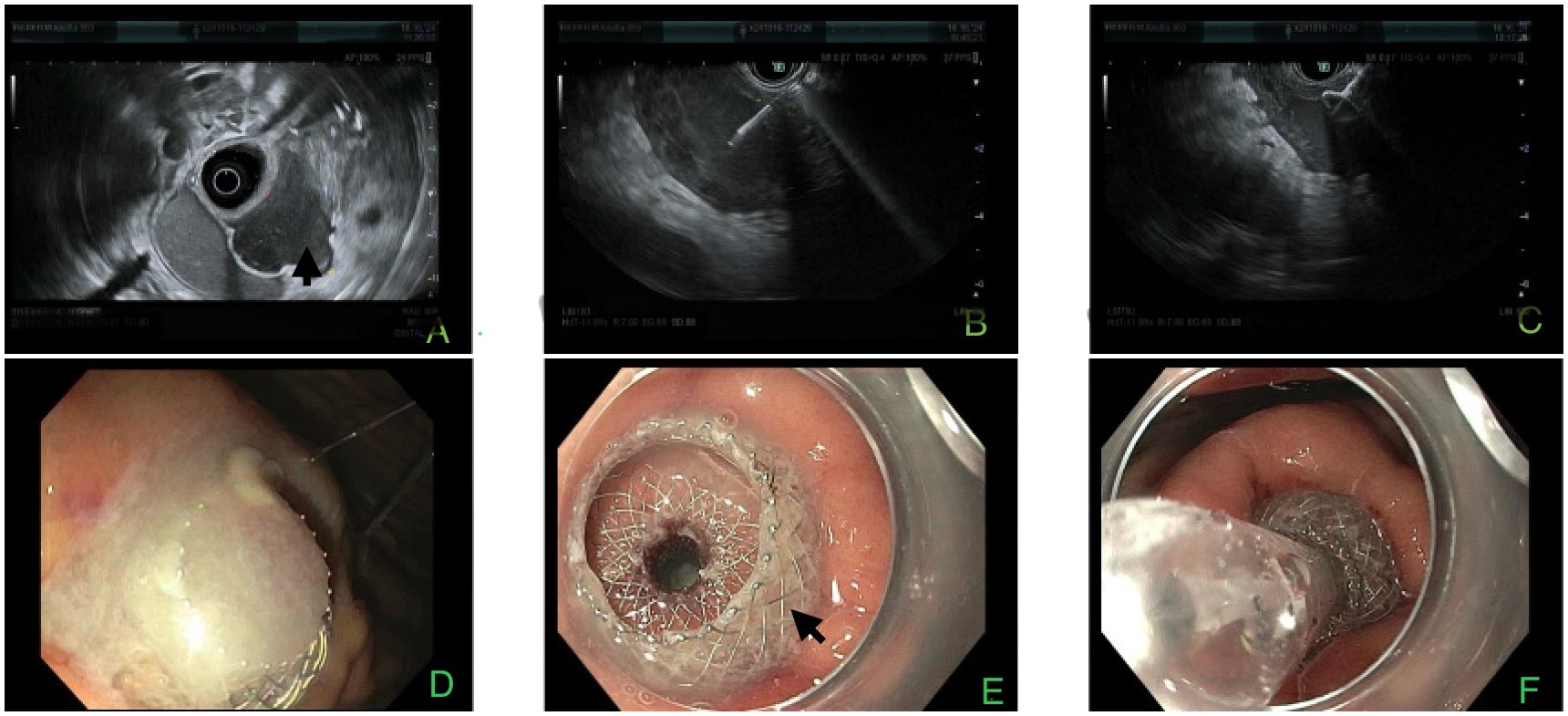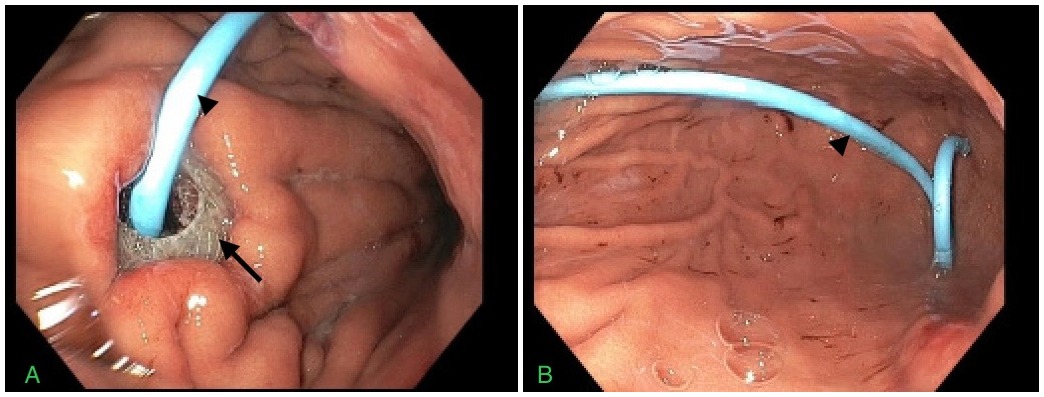Monday Poster Session
Category: Interventional Endoscopy
P3567 - Endoscopic Drainage of a Parasplenic Abscess Using Lumen-Apposing Metal Stent in a Pediatric Patient: A Novel Approach
Monday, October 27, 2025
10:30 AM - 4:00 PM PDT
Location: Exhibit Hall

Lefika Bathobakae, MD, MPH
St. Joseph's University Medical Center
Paterson, NJ
Presenting Author(s)
Award: ACG Presidential Poster Award
Lefika Bathobakae, MD, MPH1, Reshma John, MD, MPH1, Aqsa Sorathia, MD1, Dina Rohira, MD2, Praneeth Bandaru, MD1, Yana Cavanagh, MD1
1St. Joseph's University Medical Center, Paterson, NJ; 2St. George's University School of Medicine, Paterson, NJ
Introduction: A peri-splenic abscess is a localized pus collection surrounding the spleen that often results from infection or trauma. Owing to their rarity and vague presentation, splenic abscesses can pose a diagnostic challenge, and delayed intervention is associated with a poor prognosis. Herein, we present a novel case of para-splenic abscess drainage using a Hot AXIOSTM stent in a pediatric patient.
Case Description/
Methods: A 10-year-old boy with a learning disorder and hyperlipidemia presented to the ED with abdominal pain and multiple episodes of bilious emesis. Triage blood tests were significant for leukocytosis (18.5 x 103/mm3) and high anion gap metabolic acidosis with a lactic acid of 8.3 mmol/L. CT of the abdomen and pelvis revealed ruptured appendicitis and diffuse peritonitis. The patient underwent an emergent exploratory laparotomy, appendectomy, peritoneal irrigation, and drain placement.
Hospital course was complicated by wound dehiscence requiring surgery, persistent sepsis, and a para-splenic abscess. The abscess was not amenable to percutaneous catheter drainage (PCD) because of its location. To avoid invasive surgical drainage and spare the immunologic function of the spleen, an advanced endoscopist was consulted for potential endoscopic drainage using lumen-apposing metal stents (LAMS). EUS showed a 60 x 40 mm peri-splenic abscess with a mass effect on the proximal gastric body at the greater curvature and posterior wall (Figure 1). Color Doppler imaging was performed prior to needle puncture to assess for vascular structures within the needle path. One pass was made with a 19-gauge needle using the transgastric approach, and 20 mL of fluid was drained. The abscess was drained using a Hot AXIOSTM stent and a coaxial double-pigtail plastic stent as an adjunct (Figure 1 and 2). The stents were removed two weeks later, and the fistula was closed using a padlock clip.
Discussion: Splenic abscesses are typically managed with intravenous antibiotics, IR-guided PCD, or splenectomy.1–4 EUS-guided abscess aspiration is an exciting alternative to these interventions given its noninvasive nature. In our case, it was preferred to open surgery for better patient outcomes. This novel approach spared the immunologic function of the spleen, which is particularly essential in pediatric patients.4 To date, only a handful of cases of EUS-guided splenic abscess drainage using LAMS have been reported but none of them involve a pediatric patient, which underscores the uniqueness of our case.2,8–11

Figure: Figure 1. Figure 1. Endoscopic and sonographic images showing a para-splenic abscess (short black arrow; panel A-C) and a Hot AXIOS stent deployment into the abscess cavity (long black arrow; panel D-F).

Figure: Figure 2. Figure 2. Endoscopic images showing a double pigtail stent placement into the abscess cavity through the Hot AXIOS stent (black arrows).
Disclosures:
Lefika Bathobakae indicated no relevant financial relationships.
Reshma John indicated no relevant financial relationships.
Aqsa Sorathia indicated no relevant financial relationships.
Dina Rohira indicated no relevant financial relationships.
Praneeth Bandaru indicated no relevant financial relationships.
Yana Cavanagh indicated no relevant financial relationships.
Lefika Bathobakae, MD, MPH1, Reshma John, MD, MPH1, Aqsa Sorathia, MD1, Dina Rohira, MD2, Praneeth Bandaru, MD1, Yana Cavanagh, MD1. P3567 - Endoscopic Drainage of a Parasplenic Abscess Using Lumen-Apposing Metal Stent in a Pediatric Patient: A Novel Approach, ACG 2025 Annual Scientific Meeting Abstracts. Phoenix, AZ: American College of Gastroenterology.
Lefika Bathobakae, MD, MPH1, Reshma John, MD, MPH1, Aqsa Sorathia, MD1, Dina Rohira, MD2, Praneeth Bandaru, MD1, Yana Cavanagh, MD1
1St. Joseph's University Medical Center, Paterson, NJ; 2St. George's University School of Medicine, Paterson, NJ
Introduction: A peri-splenic abscess is a localized pus collection surrounding the spleen that often results from infection or trauma. Owing to their rarity and vague presentation, splenic abscesses can pose a diagnostic challenge, and delayed intervention is associated with a poor prognosis. Herein, we present a novel case of para-splenic abscess drainage using a Hot AXIOSTM stent in a pediatric patient.
Case Description/
Methods: A 10-year-old boy with a learning disorder and hyperlipidemia presented to the ED with abdominal pain and multiple episodes of bilious emesis. Triage blood tests were significant for leukocytosis (18.5 x 103/mm3) and high anion gap metabolic acidosis with a lactic acid of 8.3 mmol/L. CT of the abdomen and pelvis revealed ruptured appendicitis and diffuse peritonitis. The patient underwent an emergent exploratory laparotomy, appendectomy, peritoneal irrigation, and drain placement.
Hospital course was complicated by wound dehiscence requiring surgery, persistent sepsis, and a para-splenic abscess. The abscess was not amenable to percutaneous catheter drainage (PCD) because of its location. To avoid invasive surgical drainage and spare the immunologic function of the spleen, an advanced endoscopist was consulted for potential endoscopic drainage using lumen-apposing metal stents (LAMS). EUS showed a 60 x 40 mm peri-splenic abscess with a mass effect on the proximal gastric body at the greater curvature and posterior wall (Figure 1). Color Doppler imaging was performed prior to needle puncture to assess for vascular structures within the needle path. One pass was made with a 19-gauge needle using the transgastric approach, and 20 mL of fluid was drained. The abscess was drained using a Hot AXIOSTM stent and a coaxial double-pigtail plastic stent as an adjunct (Figure 1 and 2). The stents were removed two weeks later, and the fistula was closed using a padlock clip.
Discussion: Splenic abscesses are typically managed with intravenous antibiotics, IR-guided PCD, or splenectomy.1–4 EUS-guided abscess aspiration is an exciting alternative to these interventions given its noninvasive nature. In our case, it was preferred to open surgery for better patient outcomes. This novel approach spared the immunologic function of the spleen, which is particularly essential in pediatric patients.4 To date, only a handful of cases of EUS-guided splenic abscess drainage using LAMS have been reported but none of them involve a pediatric patient, which underscores the uniqueness of our case.2,8–11

Figure: Figure 1. Figure 1. Endoscopic and sonographic images showing a para-splenic abscess (short black arrow; panel A-C) and a Hot AXIOS stent deployment into the abscess cavity (long black arrow; panel D-F).

Figure: Figure 2. Figure 2. Endoscopic images showing a double pigtail stent placement into the abscess cavity through the Hot AXIOS stent (black arrows).
Disclosures:
Lefika Bathobakae indicated no relevant financial relationships.
Reshma John indicated no relevant financial relationships.
Aqsa Sorathia indicated no relevant financial relationships.
Dina Rohira indicated no relevant financial relationships.
Praneeth Bandaru indicated no relevant financial relationships.
Yana Cavanagh indicated no relevant financial relationships.
Lefika Bathobakae, MD, MPH1, Reshma John, MD, MPH1, Aqsa Sorathia, MD1, Dina Rohira, MD2, Praneeth Bandaru, MD1, Yana Cavanagh, MD1. P3567 - Endoscopic Drainage of a Parasplenic Abscess Using Lumen-Apposing Metal Stent in a Pediatric Patient: A Novel Approach, ACG 2025 Annual Scientific Meeting Abstracts. Phoenix, AZ: American College of Gastroenterology.

